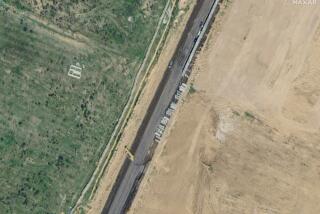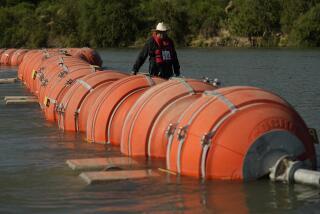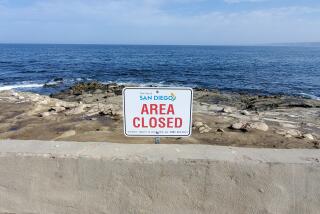Firing Up New Weapon in Fallouja: The Bulldozer
- Share via
FALLOUJA, Iraq — As U.S. aircraft mounted heavy fire against Iraqi snipers Wednesday, Marines began building an earthen barrier around this Sunni Triangle city, suggesting that the U.S. does not anticipate an immediate resolution of the standoff.
A tenuous cease-fire has been in effect since Sunday and members of the Iraqi Governing Council have attempted to negotiate a truce between the U.S. forces and the militants. But the Iraqi fighters have conducted repeated assaults against the Marines, who have responded with gunfire and airstrikes.
Officials of the U.S.-led Coalition Provisional Authority met with the mayor of Fallouja and other dignitaries to determine whether they could help resolve the conflict without further combat.
The barrier ringing Fallouja will enable the Marines to further restrict the flow of people and vehicles in and out of the city. Marines have been operating checkpoints on major roads, but the U.S. forces are spread thin in open stretches.
“It [the barrier] opens up our options, both short-term and long-term,” said Maj. Brandon McGowan, executive officer of the 2nd Battalion, 1st Marine Regiment, one of three battalions assigned to Fallouja.
The roar and snort of bulldozers added to what have become the common sounds on the outskirts of this city -- the call to prayer from numerous mosques, the buzz of unmanned surveillance planes and the occasional burst of gunfire and mortar rounds.
That shooting intensified Wednesday as fighters fired rocket-propelled grenades at a U.S. Cobra attack helicopter. Early Wednesday, an American AC-130 gunship fired on a row of buildings on the outskirts of the city that Marines said was a staging area for ambushes. A similar attack in the evening set off an explosion believed to be an arms cache.
During the day, American fighter jets hit two other insurgent targets, sending clouds of thick smoke into the air.
Marines aiming .50-caliber machine guns at a row of houses several hundred yards away guarded the construction crews on the barrier project.
In one stretch, bulldozing was being done by Marine combat engineers from Camp Pendleton and Army troops from Oklahoma.
“We did plenty of berming last year,” said Marine Chief Warrant Officer Wayne Duree, 30, of Houston, a reference to the months after the fall of the Saddam Hussein regime when Marines assumed responsibility for a southern portion of the country.
Many of the bulldozers were similar to those seen on civilian construction projects. But others looked like iron pyramids and were specially built for the military to protect the operator from gunfire.
“It’s just a massive, mean-looking bulldozer,” said Marine Lt. Paul Krumenacker, 33, of New York.
As the bulldozers pushed huge mounds of dirt, Cpl. Justin Johnson, 21, of Roseville, Calif., said the barrier, meant to block vehicles, is unmistakable in its meaning to insurgents.
“We’re drawing a line in the sand: Don’t cross it,” he said. “It’s easy for them to understand.”
The barrier also seemed to suggest that the U.S. was looking for options other than pulling back its forces from Fallouja -- which the top brass has repeatedly said was unthinkable -- or mounting an immediate assault on fighters holed up in the populous downtown area.
Although the barrier is the most obvious sign, there are other indications that the Marines are preparing for an indefinite stay in their camps around Fallouja. Navy doctors have redoubled efforts to counsel troops about the need for good hygiene, the kind of lectures given when troops are not on the move.
Sgt. Maj. Randall Carter, 42, of Brooklyn, a 25-year veteran of the corps, has told non-commissioned officers not to permit any slack in how Marines dress, meaning no rolled-up sleeves, no personalizing of their helmets and no stripping down to T-shirts unless authorized to do so.
“I don’t want them to start becoming individuals,” Carter said. “We’re a unit.”
More to Read
Sign up for Essential California
The most important California stories and recommendations in your inbox every morning.
You may occasionally receive promotional content from the Los Angeles Times.













